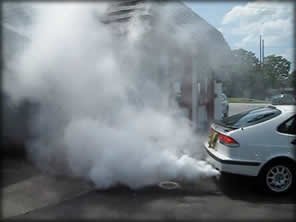- White Smoke - with white smoke coming from the exhaust pipe, this is a sure fire way to know that your engine is burning coolant.
- Bad Compression - If your engine has two cylinders next to each other with 0 compression accompanied with coolant loss or overheating, odds are you have a blown head gasket.
- Excessive Coolant Loss - If you have ruled out all external possibilities of coolant loss it is time to look internal. The most common internal reason for coolant loss would be a blown head gasket. Sometimes(most common on GM engines with Dex-Cool) the intake gasket can also leak internally.
Related Question:
This van's water pump went out and we replaced it before Nov. We also had to replace the idler pulley(?) and serpentine belt shortly after that. Then, the temperature gauge kept jumping to HOT every time you started it. It would sound like something was boiling under the hood. I would shut it off immediately and nothing was ever found leaking or pouring out of it. I haven't started it in awhile. Does you have any ideas? I talked to a couple of people and the first thing they mentioned was the thermostat, but complained that it was allot of work to change in this vehicle.One of my friends also said it could be a blown head gasket. Does this sound like the symptom and how do I repair it. I really need my van fixed. Any ideas would be greatly appreciated! ! Thanks, Tammy
RESPONSE:
It would have been good practice to replace the thermostat when you changed the water pump. My guess is the thermostat is sticking closed. The boiling noise you hear is probably the coolant returning to the overflow tank. It is usually not that hard of a job to change it. Most anyone with a little mechanical ability could do this. Make sure to clean off the old gasket and replace with a new one, be sure and mount the thermostat right side up. If this does not solve the problem you may have a blown head gasket. Have someone do a compression check on each cylinder for this.
All cylinders should be within 20 psi of each other. If you find one is much lower , then you have a blown head gasket. I like to pressure test cooling systems with a pressure tester to check for leaks that you might not be able to otherwise detect. If you notice a small external leak, you can add Bar's Stop Leak as a temporary fix. You just add it to the radiator and top off the coolant and drive it.
Repairing a blown head gasket requires special tools and will require lots of time. I do not recommend doing this yourself unless you are comfortable working on cars and have access to a torque wrench. You can get access to the repair procedures and torque specs with a Auto Repair Manual.









